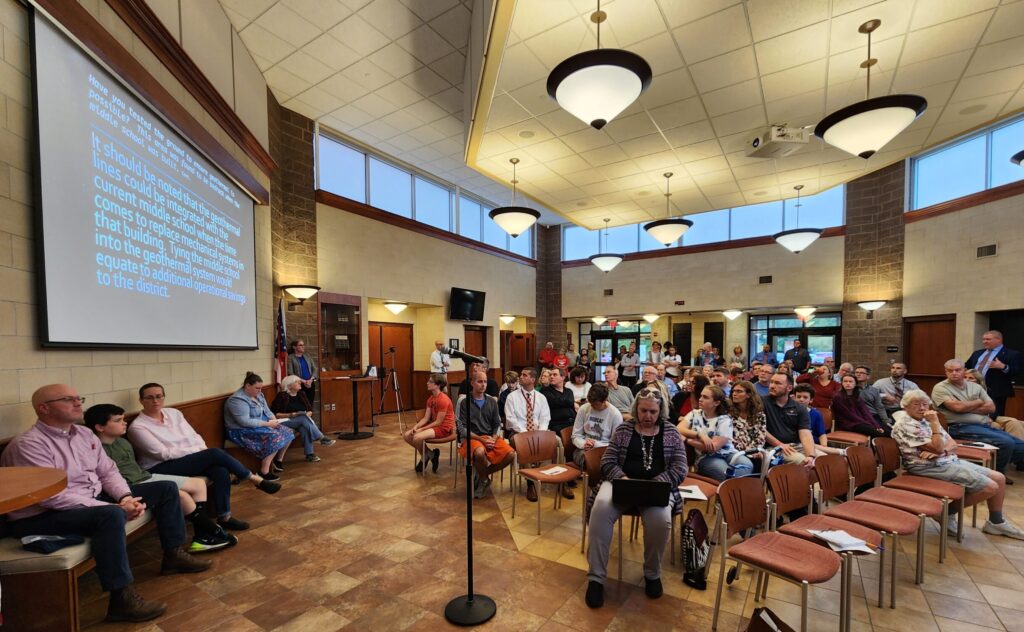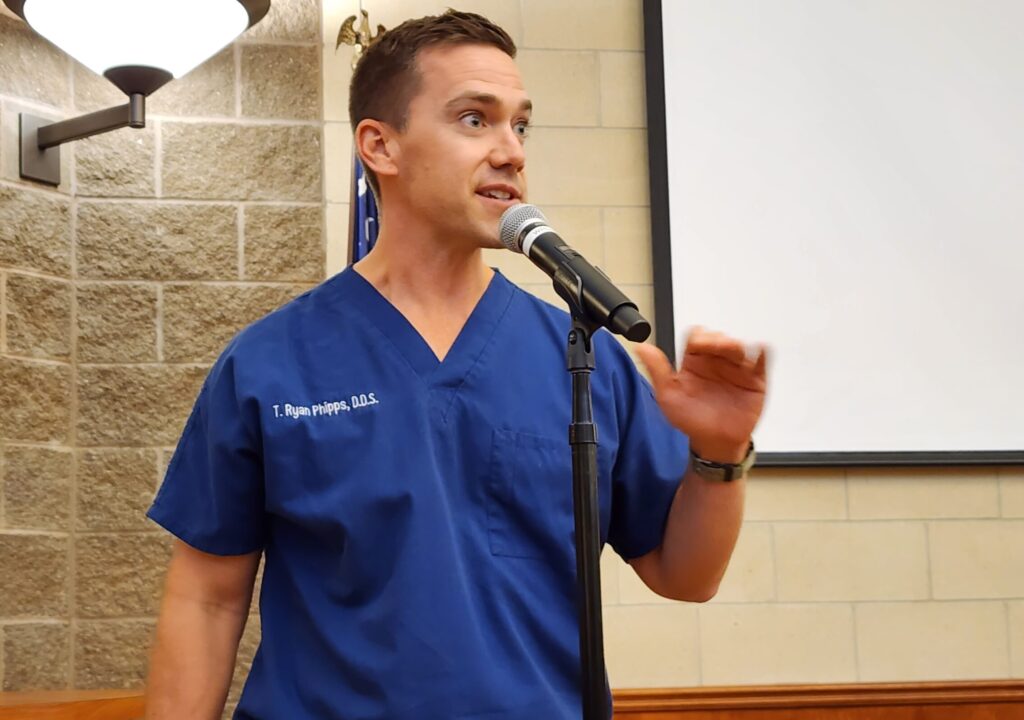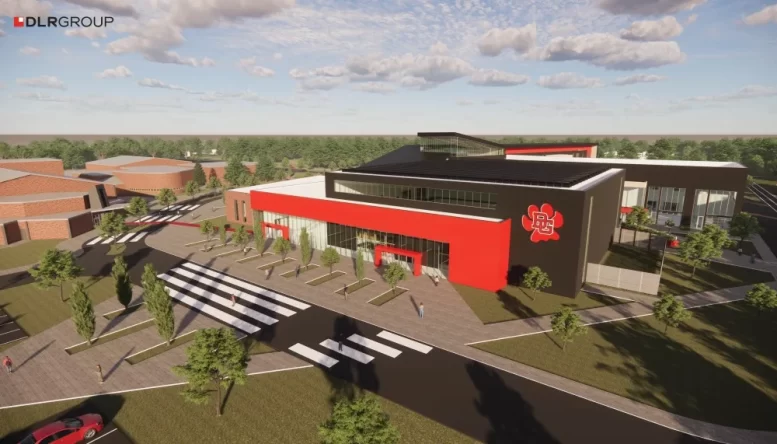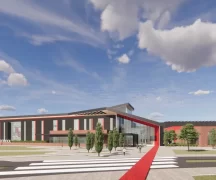By JAN LARSON McLAUGHLIN
BG Independent News
Bowling Green Superintendent Ted Haselman is working to fend off complaints about lack of transparency. In doing so, he spent a good deal of time at Tuesday’s Board of Education meeting answering questions about the new high school proposal – covering everything from money, to the new location for marching band practice, and back again to money.
The final plan for the new high school will be presented to the board of education and the public on Oct. 4 at 6 p.m. – after which the board will vote on the master plan.
On the same evening, the district will be offering citizens a chance to walk through the existing high school, built in 1963.
“We’re trying to be as open and transparent as possible. Come and look at what we have,” Haselman said Tuesday evening.
For residents who want to see the new high school plan, the district posted more information on its website Tuesday, including https://resources.finalsite.net/videos/t_video_mp4_480/v1695063143/bgcsk12ohus/hrdj4uwvgbqp0hzmrrrj/BGCS_Animation_Final.mp4
To fund the new high school, the district will have a $72.8 million bond issue on the Nov. 7 ballot.
Haselman was serious when he said he would answer the many questions posed by local citizens about the high school project after the design was first presented last month. During Tuesday’s board meeting, the superintendent responded to questions about state assistance, building uses, renovation costs, geothermal energy and band practices.

Following are some of those questions and answers:
- How much is the OFCC paying for the new high school? As of Sept. 14, the district was advised it would get a 17% reimbursement of the items OFCC is willing to co-fund. That turns into about $7.5 million that the district would receive when it’s BG’s turn for funding in five to 10 years.
- How much would it cost to renovate the current high school? According to the OFCC, it would cost $47.5 million to renovate, compared to $64.1 million to build new. That is close to the district cost of $62.3 million for the new high school, minus the cost for the activity center. Using the OFCC’s threshold for a feasible renovation, the state would not co-fund a renovated BG high school because the costs are too high.
- How long would construction take? If the levy passes in November, the groundbreaking would likely be May 2025, with a target opening in August 2027. Following that, a large portion of the old high school will be demolished, and remaining space will be turned into an “activity center.”
- How much will the bond issue cost me? Every voter should check out the levy estimator on the Wood County Auditor’s website, Haselman suggested.
- Why isn’t the new high school going to be connected to the Performing Arts Center or the proposed activities center? According to the Ohio Facilities Construction Commission, if the new school is physically connected to the existing space, the district would get funded for less space or get a lower reimbursement on the project.
- What exactly is the activity center? It’s the space currently used for music, cafeteria, the main gym and auxiliary gym. It would not be used for regular school classes, but would offer space for a Family Resource Center in response to growing needs of district families. The extra gym areas would mean more space for elementary through varsity team practices, so students wouldn’t have to practice late into the evening.
- What’s going on with Penta classes? Haselman explained there was some miscommunication before about the program. The classes would remain under the Penta umbrella, and would continue to be held at the new high school.
- Will taxes go up the same percentage as the recent property revaluation? No, Haselman said. “Taxes do not increase in direct proportion to your property valuation,” he explained. Because the district is asking for a $72.8 million bond issue, that is all that can be collected – regardless of increasing property values.
- Has the ground been tested to make sure geothermal heating and cooling can be used at the new school building? According to Haselman, the design firm for the project, DLR Group, says it can.
- Is the district planning for the right class sizes? The OFCC has used demographic data to recommend the building sizes and needs of the district, Haselman said.
- Where will the marching band practice, since the new high school would cover the parking lot area now used by the band? A decision hasn’t been made, but the district is looking at the grassy area in front of the current high school. The band tower, which was constructed as an Eagle Scout project, will be moved to wherever the practice area is established.

Also at Tuesday’s meeting, Ryan Phipps, a member of BG Families for Schools, presented some information that could be helpful as voters consider the school bond issue.
To show the age of high school buildings in the county, Phipps listed the year of construction for some, including:
- Rossford, 2020.
- North Baltimore, 2012.
- Otsego, 2007.
- Elmwood, 2004.
- Perrysburg, 2001.
- Bowling Green, 1963.
Phipps also compared the amount of taxes collected in neighboring school districts, using a home valued at $150,000 and a household income of $60,000. He listed how much less Bowling Green City School District residents pay than those in other districts:
- $126 less than Elmwood.
- $216 less than Otsego.
- $318 less than Eastwood.
- $498 less than Fostoria.
- $570 less than Rossford.
- $894 less than North Baltimore.
- $1,125 less than Perrysburg.


